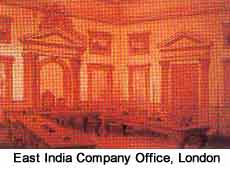

 |  |
 From this time the company steadily developed its activities. Its first headquarters (from 1612) was at Surat which was moved to Bombay in 1674 (a wedding gift of Charles II's Portuguese queen Catherine transferred to the company). In 1640 a factory was established at Madras on a plot of land leased from one of the last Vijayanagar rulers. By 170o, however, they too were sub)Ccts of the Mughal. In Bengal, attractive for saltpetre and silks, a factory was set up at Hughli, to be replaced in i6go by Calcutta, a malarial swamp redeemed by a deep water anchorage. Rciadons in general were harmonious except for a time when Sir Josiah Child, an ambitious Company chairman, thought that the time had come to 'lay the foundation of a large, well-grounded, sure English dominion in India for all time to come'. His expedition to Chittagong was a failure; the English merchants were expelled by Aurangzeb's officers from Bengal and Surat.
From this time the company steadily developed its activities. Its first headquarters (from 1612) was at Surat which was moved to Bombay in 1674 (a wedding gift of Charles II's Portuguese queen Catherine transferred to the company). In 1640 a factory was established at Madras on a plot of land leased from one of the last Vijayanagar rulers. By 170o, however, they too were sub)Ccts of the Mughal. In Bengal, attractive for saltpetre and silks, a factory was set up at Hughli, to be replaced in i6go by Calcutta, a malarial swamp redeemed by a deep water anchorage. Rciadons in general were harmonious except for a time when Sir Josiah Child, an ambitious Company chairman, thought that the time had come to 'lay the foundation of a large, well-grounded, sure English dominion in India for all time to come'. His expedition to Chittagong was a failure; the English merchants were expelled by Aurangzeb's officers from Bengal and Surat. The Calcutta factory with its fortified factory of Fori-William, was one result of this episode. Thereafter a chastened company took care not to challenge die empire again until there was hardly anything left to challenge in 1756. For a time it was preoccupied by a struggle with a rival company till the union of the two in the United Company in 1708. The trade pattern was different for different region. In the west the main articles were cotton piece-goods, cotton yarn, and indigo from Gujarat; from the Malabar coast pepper and such other spices as could be bought second-hand from Ceylon and the East Indies; from Madras and the south-cast coast again piece-goods, and yarn and sugar; from Bengal specially silks and saltpetre. In return India bought metals such as tin, lead, and quicksilver, novelties, specialty mechanical ones, tapestries, and ivories. But these purchases never equalled the Company's payments. India would take little of England's staple product of broadcloth so that the balance had to be made up with silver bullion. next page >> |
Copyright ©2000 indiansaga.info. All rights reserved.
By using this service, you accept that you won't copy or use the data given in this website for any commercial purpose.
The material on indiansaga.info is for informational & educational purpose only.
This site is best viewed at 800 X 600 picture resolution.